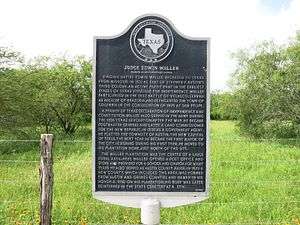Edwin Waller
| Edwin Waller | |
|---|---|
|
Judge Edwin Waller historical marker is west of Pattison, Texas at FM 1458 and Buller Road. | |
| Born |
November 4, 1800 Spotsylvania County, Virginia |
| Died |
January 3, 1881 Austin, Texas |
| Resting place | Texas State Cemetery |
Edwin Waller (November 4, 1800 – January 3, 1881) was an entrepreneur, signer of the Texas Declaration of Independence, the first mayor of Austin, Texas, and the designer of its downtown grid plan.
Texas independence
He was born in Spotsylvania County, Virginia, United States, in 1800 to a family settled in the state since colonial times when they emigrated from Buckinghamshire, England. His family later settled in Missouri.
In April 1831, he immigrated to the Mexican state of Coahuila y Tejas. On July 20, he received a land grant from the government in present-day Brazoria County. He began a shipping business, transporting cotton from Velasco, Texas, to New Orleans, Louisiana, using his ship, the Sabine, and was once briefly arrested in Velasco for refusing to pay Mexican customs duty.
He very quickly became active in the movement for Texas independence from Mexico. On June 26, 1832, he fought and was wounded at the Battle of Velasco, an early skirmish in the Texas Revolution. In 1833, he became the alcade of Brazoria Municipality. In 1835, he represented the Columbia Municipality at the Consultation in San Felipe de Austin, where he was chosen by the members to serve in the General Council of the Provisional Government of Texas.
On February 1, 1836, he was elected as the Brazoria delegate to the Convention of 1836 in Washington-on-the-Brazos, where he signed the newly adopted Texas Declaration of Independence on March 2. At the convention, he served on the committee that helped draft the Constitution of the Republic of Texas.
Other pursuits
In 1839, he was chosen by Texas President Mirabeau Lamar to survey the site, sell lots, and erect public buildings for the new state capital in Austin. The original landsite for the capital was narrowed to 640 acres (2.6 km²) that fronted the Colorado River between two creeks, Shoal Creek and Waller Creek, which was later named in his honor. The fourteen-block grid plan was bisected by a broad north-south thoroughfare, Congress Avenue, running up from the river to Capital Square, where the new Texas State Capitol was to be constructed. A temporary one-story capitol was erected on the corner of Colorado and 8th streets. On August 1, the first auction of 306 lots was held. The grid plan that Waller designed and surveyed now forms the basis of the streets of downtown Austin.
On October 13, 1839, he offered his house for the meeting place to establish the first Masonic Lodge in Austin .
On January 13, 1840, he was elected the first mayor of Austin. He resigned before the end of his term, however, and moved to Austin County. A new county formed from parts of Austin County and neighboring Grimes County was renamed Waller County in his honor in 1873.
In 1861 Waller represented Austin County at the Texas secession convention. As one of the last living signers of the Texas Declaration of Independence, he was given the honor of signing the secession ordinance first after the convention president Oran Milo Roberts.
In 1873 Waller served as the first president of the Texas Veterans Association.
He died on January 3, 1881 in Austin, where he moved shortly before his death to live with one of his daughters. He was buried in Waller County, but his remains were later moved to the Texas State Cemetery in Austin.
External links
- Edwin Waller from the Handbook of Texas Online
- Texas State Cemetery: Edwin Waller
- Entry for Edwin Waller from the Biographical Encyclopedia of Texas published 1880, hosted by the Portal to Texas History.
- History of Austin Lodge #12
- KLRU: Austin History
- Waller Creek
- Texian Independence Convention Delegates
